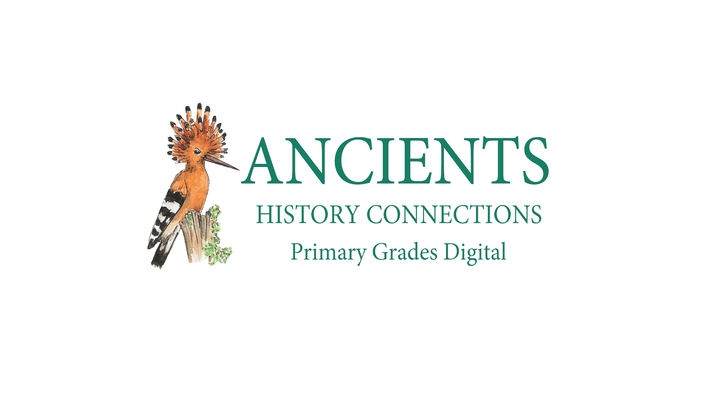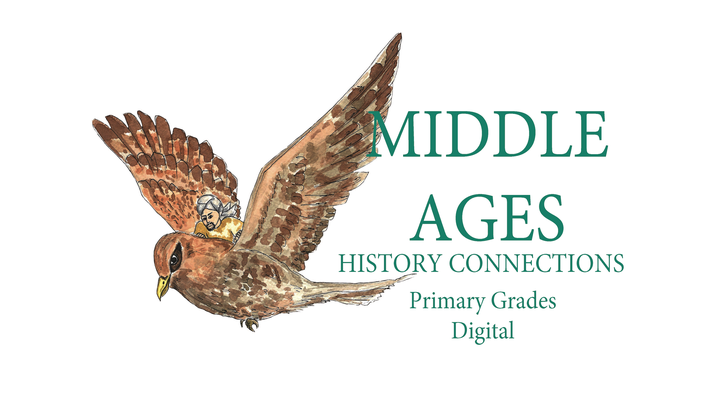
History Connections - Ancients
Middle Grades
Book 1
The ancients start at the beginning of mankind and end with the birth of prophet 'Esa (as).
During the middle years (grade 5 through 8), students will cycle through the same historical periods and science topics as in the primary years, but they will learn how to make connections and study biographies. They will increasingly learn how to ask questions and extract information from a text. On top of that, middle graders will learn several note taking skills, and how to present the information from a text into a graphic. Information is offered, processed and represented in different formats.
This book integrates Islamic concepts into global history and is packed with hands-on activities, visuals. Additionally, the way information is presented caters to different learning styles, in accordance with our unique teaching methodology IDEALS (See more about this below).
The first book is best suited for late primary students, grade 5 and 6, although older students would benefit from this program as well.
Digital Format
Not an e-book, not an e-course
We have created a unique format for our Middle Grades book 1 -Ancients. It is not an e-book, and it is not an e-course.
Our digital format allows parents to have all the materials in one place and teach their child. Lesson plans are placed side by side with the worksheets and resources.
All student materials are printable.
All you need for the entire year in one place.
No shipping needed!
What is Included?
The History Connections Middle Grades Book 1 – Ancients digital program includes the following:
- History Connections Middle Grades Book 1 – Ancients
- History Connections Middle Grades Book 1 – Ancients Maps & Worksheets (Needs to be printed)
- World Wall Map (Needs to be printed & assembled)
- Tree Trunk Timeline (Needs to be printed & assembled)
- Usborne Internet Linked History Encyclopedia
- History Intersections
That is a total value of $167!
If you pay for the entire year, you only pay $145.19!
That is less than 10$ per month!
Don't want to pay upfront?
A payment plan is available for $12.09 per month for 13 months.
All you need for the entire year in one place online!
No hassle with shipping, no heavy books to carry!
You will get access for 13 months to complete the 30 weeks of lessons.
Not sure yet if this is there right fit for you?
Try the curriculum for a day in a FREE trial!
Curriculum
Elements in the lessons:
Research: Learning how to read and understand a scientific text is an important life-skill. It helps create life-long and independent learners. In the Research box of the weekly Task Card, the key words are listed. You are encouraged to find the topics in the encyclopedia by yourself, by using the content pages or the index pages. The keywords listed help you in finding the topics in the encyclopedia.
Resources: We have listed the resources that will be used for the week in the resources section of the weekly Task Card. UILE stands for the Usborne Internet Linked History Encyclopedia, HI stands for History Intersections, 2nd edition and the Super Servants Stories are optional.
Skill: The program covers a wide range of skills, including outlining, summarizing, note-taking and mind mapping. These skills are not only useful for the subject of history, but are life-skills to be used throughout a wide range of subjects, both academic as well as non-academic. The difficulty of the skills will be increased over several weeks, allowing you to become proficient through small incremental steps.
Project: Every week, you will create a project: sometimes this is with pen and paper and sometimes this is with an online software. The purpose of the project is to show information you have found in a visual manner.
Map: You will make a map by tracing a Location Map and following the instructions every week. The instructions will tell you what items should be marked and labeled on the map. The map should be made with colors and have as much details as possible. Every map should be labeled at the top with the topic of the week. The purpose of having you trace the map is recognition of topographical landmarks and elements such as mountain ranges, rivers, deserts, seas and oceans, and cities. By physically tracing a map, the information is integrated into your memory. Most Location Maps are traced more than once.
Timeline: Timelining involves the placement of information in chronological order on a visual that represents the passage of time. Most timelines are linear, starting from one point and moving in one direction. Such timelines will give a good sense of the order events are happening in, and which events happen at the same time. However, a linear timeline does not show the different topographical area things happen in at the same time. Therefore, our timeline is circular: it is shaped like a slice of a tree trunk, with the rings showing its years. We have also divided the circular timeline in ‘slices’, like a pizza. Every slice represents a different area of the world. When data is added to the timeline, all events happening in the same rings are happening at the same time, and going from the center to the outer ring in each slice, will show the order events happened in for that particular area.
Every week, you will write the chronological information found (and if applicable, the information in the boxes in the resources,) on the timeline in the topographical area the events took place in. Not only time matters, but also place. See instructions below on how to assemble the timeline.
World Wall Map: In order to have a sense where events on the traced map take place on a global scale, we will ask you to locate the traced map area on the World Wal Map. The World Wall Map is a complete world map without details.
History Connections
History in Context
Our history program is called History Connections, because learning history is all about connections: connections to the past, and connections to each other. Knowing what happened in the past helps us make sense of our present. Knowing how we fit into the larger global history, helps us connect to others. Knowing our heritage gives us a place to belong. Knowledge of history even gives us a basis to determine future actions. Currently, the world has become a global community, making global history all the more pressing. This program focusses on teaching 21st century skills, rather than rote memorization of facts, as this teaches students important skills to function in the modern society of the future.
Our History Connection series covers the ancients all the way up to the modern history and current issues. This series is intended for grade 1 through 8.
Every year students will take a chunk of this history. In the first book, students will cover from Creation to about 500 C.E. In the second book, they will cover from 500 C.E. until about 1650 C.E. The third era will cover from 1650 C.E. until the Industrial Revolution, approximately 1850 C.E. The last era, the Modern Era, will cover from 1850 C.E. until our current day.
All Eras have Islamic History integrated within global history, with more attention and time spend on important topics in the history of our Ummah.
The four books in this curriculum are consecutive, not only in chronological information but also in building skills.
IDEALS
Our unique approach to learning is summed up in the acronym IDEALS, which covers several methodologies and skills we believe should be covered in all educational programs,whether for primary students or adults. IDEALS stands for Inquiry Based Learning, Differentiated Learning, Experiential learning, Aptitude Training, Lens of Islam, and Social-Emotional Learning.
Inquiry-based learning is an approach to learning that emphasizes the student's role in the learning process. Rather than the teacher telling students what they need to know, students are encouraged to explore the material, ask questions, and share ideas.
Differentiation means tailoring instruction to meet individual needs. Differentiation is a framework for effective teaching that involves providing all learners a range of different avenues for understanding new information.
Experiential learning is the process of learning through experience, and is more specifically defined as "learning through reflection on doing".
Aptitude Training determines how well-equipped students are to make good decisions and solve problems in their academic, professional and personal lives. Skills are the building blocks that allow students to apply the knowledge they acquire in an academic context to real world problems and situations.
Lens of Islam integrates Islamic knowledge into elements of the academic program in order to provide students with an Islamic lens to view the world and to create connections between the deen and the world at large. Viewing the world through an Islamic lens will increase a sense of purpose and meaning, and allows students to foster their Islamic identity and live with integrity.
Social-emotional Learning is the process through which students acquire and apply the skills necessary to manage emotions and social relationships. According to Goleman, social-emotional intelligence “emerges as a much stronger predictor of who will be most successful, because it is how we handle ourselves in our relationships that determines how well we do once we are in a given job”.



